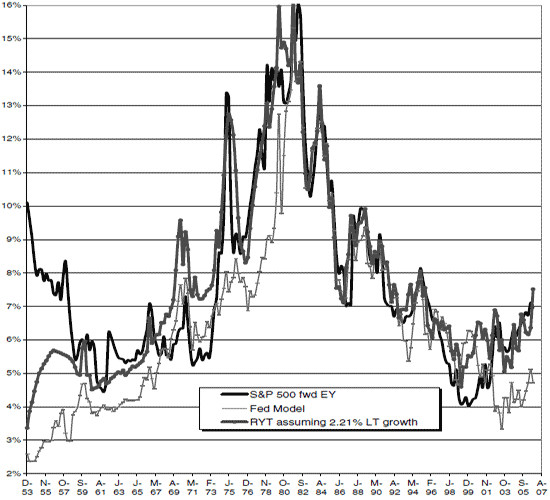What aggregate return thresholds are critical to investors in deciding whether to accept or reject equity and bonds for investment portfolios? In their December 2008 paper entitled “A Required Yield Theory of Stock Market Valuation and Treasury Yield Determination”, Christophe Faugere and Julian Van Erlach argue that investors first require that U.S. stocks and bonds in aggregate prospectively provide a real after-tax earnings yield directly related to real long-term GDP per capita growth. Investors then decide between stocks and bonds based on the better after-tax real return. Applying this Required Yield Theory (RYT) to quarterly data over the period 1953-2006, they find that:
- Real, after-tax Treasury and S&P 500 forward earnings yields reliably revert to positive means. For stocks, the mean yield is very close to the long-run average real GDP per capita annual growth rate (2.24% during 1929-2001 and 2.03% during 1929-2006).
- The equity risk premium derives mostly from business cycle risk, as measured by the growth in book value of equity per share (productivity growth). Inflation risk and fear-based risk have only transient, secondary impacts on the premium. The equity premium is always positive or zero relative to long-term Treasuries, but may be negative relative to short-term Treasuries when short-term productivity outpaces medium-term and long-term trends.
- Periods when the after-tax 30-year Treasury bond yield is below the nominal required yield indicate that a fear-based premium is present.
- Using quarterly data, the RYT Model fits the S&P 500 forward earnings yield with adjusted R-squared statistics of 88% over 1953-2006 and 94% over 1978-2006, about 19% better than the fit provided by the Fed Model (see chart below). Transient deviations from the model arise from: (1) economic, productivity or policy shocks that impact the equity risk premium; (2) shocks to earnings, productivity or inflation forecasts; and, (3) short-term noise trading.
- Treasury yields are a function of short-term productivity growth relative to its long-term trend. The RYT Model fits the yields on 1-year, 10-year and 30-year Treasuries with adjusted R-squared statistics over 66%.
- Using the difference between long-term and short-term growth in aggregate book value per share, the RYT Model largely explains the spreads in yields between long-term and short-term Treasuries (term spread), with adjusted R-squared statistics over 58%. The model successfully generates 10 of 12 yield curve inversions over the sample period.
- RYT partially validates the Fed Model since both the S&P 500 forward earnings yield and the 10-year Treasury yield both derive from the required yield (long-term real U.S. GDP per capita growth).
The following chart, taken from the paper, shows the actual S&P 500 forward earnings yield, the investor-required yield from the RYT Model and the earnings yield specified by the Fed Model over the entire 1953-2006 sample period, based on quarterly data. The RYT Model fits the S&P 500 forward earnings yield with an adjusted R-squared statistic of 88%, about 19% better than the Fed Model.

In summary, the Required Yield Theory supports Jeremy Siegel’s assumption that “investors bid stock prices up or down in response to changing taxes and inflation to obtain the same after-tax real return.”
Note that one of the authors, Christophe Faugere, has commenced publishing “Market Estimates” addressing the valuation status of the S&P 500 Index.